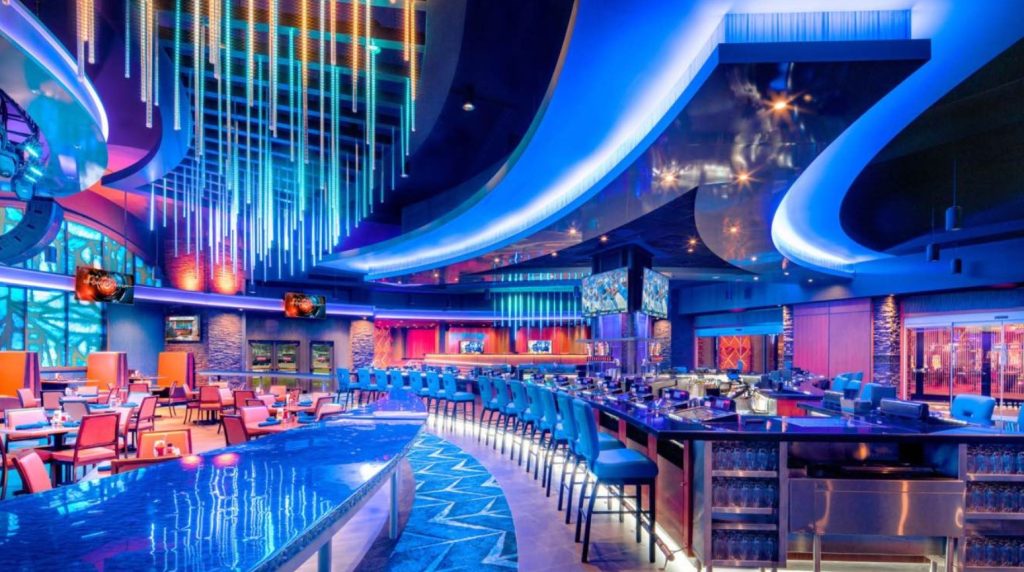Casino interior design is far more than just an aesthetic component; it is a strategic element that significantly influences player behaviour, player experience and ultimately casino profits. Every detail — from luxurious carpets to strategically placed lighting — is carefully considered creating an atmosphere that will attract, soothe and retain players. In this casino articles, we will look at the multifaceted ways in which casino interior design influences players, exploring the psychology behind design choices, the desire for comfort and convenience, the economic implications and more. Why don’t casinos have windows you ask and for such a question as why don’t casinos have windows you will find the answer here.
Casino atmosphere
The casino layout design to create a sense of other worldliness and escapism. “When you walk into a casino, you enter a world where time seems to have stopped,” notes the casino architect. This is achieved through a combination of factors such as warm, diffused lighting, lush carpeting with intricate patterns and an overall casino layout design to immerse visitors in the gaming experience. The absence of clocks and windows further separates players from the outside world, encouraging them to linger and continue playing.
Comfort and convenience in a casino
Player comfort is paramount to casino design. Every aspect is considered, from the ergonomic seating at the slot machines and gaming tables to the casino layout of the bars and toilets. These elements ensure that players stay in the casino for a long time. A recent study found that physical comfort significantly influences a player’s decision to stay in a casino longer and participate more in the games. Ease of navigation is also crucial, as a confusing casino layout can lead to player frustration and reduced time in the casino.

Psychological factors
Casino design relies heavily on psychological principles to influence player behaviour. The use of specific colours such as red and gold evoke feelings of wealth and prosperity, and the design often resembles a maze, encouraging exploration and engagement. The sounds of winning, from the tinkling of slot machines to the jubilation of winning players, are amplified to create an atmosphere of excitement and opportunity. “Casinos are adept at using psychological manipulation, from the colours to the sounds that fill the space,” explains a behavioural psychologist specializing in gambling. Casino articles will bring the curtain down on the casino.
The aesthetic appeal and luxury of casinos
The aesthetic appeal and perceived luxury of a casino plays an important role in attracting and retaining high rollers. Luxurious interiors featuring fine art, opulent chandeliers and high-end materials speak of exclusivity and prestige, attracting those seeking a glamorous gaming experience. “The luxury of a casino’s interior directly influences my decision to visit. I am attracted to establishments that offer an exceptional experience,” shares one of the regular visitors to the casino.
The genesis of luxury in casinos
The concept of luxury in casinos dates back to their early days, when establishments such as the Casino of Venice, which opened in 1638, set a precedent for grandiosity. “Casinos have always been as much a spectacle as a game of chance,” notes a historian specialising in gambling design culture. This tradition of luxury continues today, with casinos around the world utilising architecture and interior design that exude extravagance and exclusivity.
Architectural marvels and legendary designs
Many of the world’s best casinos are known not only for their gaming opportunities but also for their architectural layouts landmarks, such as the Bellagio in Las Vegas with its famous fountains or the historic elegance of Casino de Monte-Carlo in Monaco. These establishments are landmarks that attract visitors not only for their gambling design offerings but also for their architectural layouts beauty. “A casino designs is a statement, a reflection of its personality and the experience it endeavours to offer,” notes a renowned casino architect.
Creating the casino experience
Inside the casino, every element — from plush carpeting and ornate chandeliers to elaborate
lighting and artwork — is carefully selected to create an atmosphere of luxury and appeal. Casino design is often intended to evoke a sense of wonder, luxury and limitless possibilities. “Our goal is to mesmerise guests, to create a space beyond the ordinary,” shares an interior designer who specialises in high-end casino projects.
The role of exclusivity and VIP treatment
Part of the luxury of a casino lies in the exclusivity and VIP treatment offered to guests, especially high rollers. Private gaming rooms, personal hosts, and exclusive privileges are just some of the ways that casinos take care of their most valued visitors. This level of service not only enhances the overall gaming experience, but also reinforces the casino’s status as a luxury destination. The casino manager says, “The way we treat our guests, especially those in our VIP programme, reflects the luxury we embody.”
Sensory experience: engaging all the senses
The luxury of the casino is not only felt visually, but by all the senses. From the luxurious textures of the furniture, to the fine dining offered in the on-site restaurants, and even the signature scents spread throughout the gaming floor, the casino engages guests in a full sensory experience. “We create an atmosphere that affects all the senses, making every visit an unforgettable experience,” explains the casino operations expert.
The economic impact of casino luxury
The aesthetic appeal and luxury of casinos have a significant economic impact, attracting tourists and casual visitors in addition to regular players. Statistics show that integrated resorts that combine casinos with hotels, restaurants, and entertainment generate billions of dollars in revenue, contributing significantly to the local economy. “The appeal of our casino goes beyond gambling design it’s a destination,” notes one casino executive, emphasising the wider economic benefits.

The digital realm: online casinos that mimic luxury
In the digital age, online casinos are looking to emulate the luxury of their brick-and-mortar counterparts with sophisticated graphics, live dealer games and personalised customer service. While the physical elements may vary, the desire to create a sense of luxury remains the same. “Even in the digital space, the appeal of luxury is paramount. We want players to feel valued and pampered,” shares the marketing director of a leading online casino.
Economic impact
A casino floor plan design is a massive investment that directly impacts its economic success. A well-designed casino can increase attendance, player spending and overall profitability. The location of games, the availability of amenities and the overall atmosphere can influence visitor behaviour. “Our revenues are highly dependent on how attractive our casino space is. A welcoming, well-designed casino floor is critical,” notes a casino manager, confirming the economic importance of casino floor plan design.
Regulatory and practical considerations
In pursuit of aesthetic appeal and psychological impact, casinos must also be guided by regulatory and practical considerations. These include complying with security regulations, optimising crowd control and movement, and ensuring accessibility for all visitors. The challenge is to balance these considerations to create an exciting and profitable environment.
Conclusion
Casino interior design is a complex combination of art, psychology and business strategy. Every element, from lighting to casino layout design and everything in between, serves the purpose of creating an environment that influences player behaviour. As casinos continue to evolve, the strategies behind their design also change, always with the aim of enhancing the player experience and maximising economic outcomes. The magic of casino design lies not only in its ability to dazzle and entertain, but also in its ability to subtly guide player behaviour, creating an experience that is as profitable as it is impressive.





